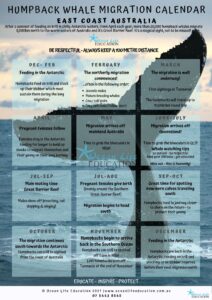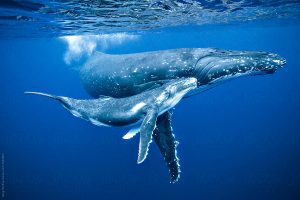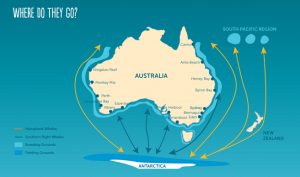
After a summer of feeding on up to 4 tonnes of krill in nutrient-rich chilly Antarctic waters, more than 20,000 Humpback Whales migrate north to the sub-tropical waters of East Coast Australia. They head to the warm waters of the Coral Sea and Great Barrier Reef, to mate and give birth. The east coast migration is one of the longest migratory journeys of any mammal on Earth – up to 10,000 km round trip! Our Humpback Migration Guide will help you make the most of one of the most incredible shows on earth…
To get the full low down on the east coast migration, check out our online course. 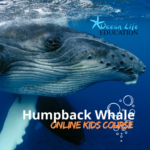
When to Watch the Humpback Migration
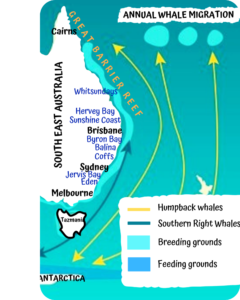 The exact timing of the humpback migration can vary slightly from year to year but generally the whales can be easily seen off the East Coast at the following times:
The exact timing of the humpback migration can vary slightly from year to year but generally the whales can be easily seen off the East Coast at the following times:
May – Aug Migrating north (generally 5-10km from the coast)
Sept – Nov Migrating back South (often with new-born calves)
This map highlights some of the best whale watching lookouts on the east coast.
Tip: The whales are normally easier to see migrating south as they tend to travel closer to shore, protecting their calves from predators.
Check out our humpback migration calendar for more details…
Time of Day 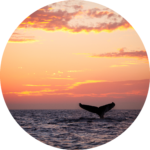
Morning – Calm morning waters make easy viewing, before the wind picks up.
Evening – Sunsets make for spectacular whale watching as the changing light highlights the action.
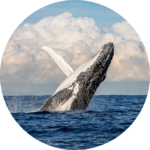 Where to Watch
Where to Watch
The humpback’s spectacular acrobatic displays are often easily observed from the beach or land-based lookouts – so everyone gets the chance to watch for free!!
Best Whale Watching on the Sunshine Coast 
The best whale watching on the Sunshine Coast can be observed from…
- Coolum: Point Perry or Point Arkwright, Coolum
- Kawana: Point Cartwright
- Moffat Beach Headland
- Noosa: Hells Gate, Noosa National Park
- Alexandra Headland
Queensland Whale Watching by Boat
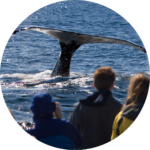 Our favorite places to go whale watching by boat…
Our favorite places to go whale watching by boat…
-Mooloolaba
-Hervey Bay: about a quarter of humpbacks enter Hervey Bay
-Whitsundays
-Great Barrier Reef
Best Whale Watching near Brisbane
In our opinion, the best whale watching near Brisbane is from…
- North Stradbroke Island – Point Lookout
Whale Watching Tips 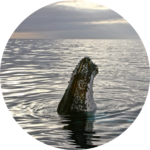
Here are our whale watching tips – to ensure you get the most from your experience
- Be respectful and mindful – follow 100 meter distance regulations
- Take binoculars
- Take a copy of our Identifying Humpbacks guide so you know what you’re looking for
- Get up high for a better view
- Be patient
- Get educated so you can impress your friends with the facts!
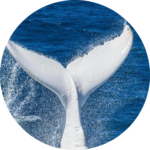
Don’t forget to look out for East Coast Australia’s most famous white humpback whale. It’s Aboriginal name is ‘Migaloo’ or ‘white fella’.
Why We Need Whales
Whales are essential to the marine eco-system and therefore to us. They help to keep our oceans healthy. As we get up to 70% of our oxygen from the sea, we need it to be healthy enough to produce that oxygen, else we humans can’t survive!
5 Ways You Can Protect Whales 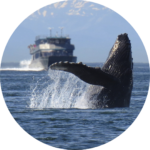
- Educate yourself & your friends
- Whale watch with a responsible company & keep 100 metres away
- Report sick or injured animals
- Reduce plastic usage & do not litter
- Support a whale charity:
Whale & Dolphin Conservation
Marine Conservation
Sea Shepherd
Humpbacks & Highrises
 To get educated about the humpback migration and why we need to protect whales, why not check out our online course for kids
To get educated about the humpback migration and why we need to protect whales, why not check out our online course for kids
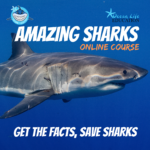 Interested in other courses for kids? Check out our Amazing Sharks Course
Interested in other courses for kids? Check out our Amazing Sharks Course


